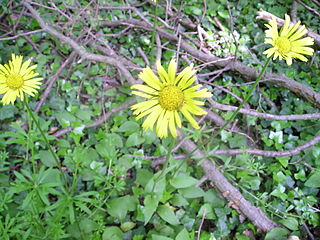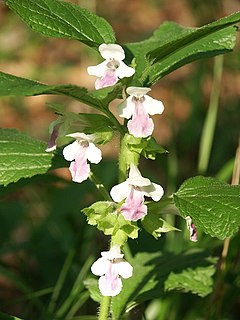
Lamium (dead-nettles) is a genus of about 40–50 species of flowering plants in the family Lamiaceae, of which it is the type genus. They are all herbaceous plants native to Europe, Asia, and northern Africa, but several have become very successful weeds of crop fields and are now widely naturalised across much of the temperate world.

Glebionis segetum is a species of flowering plant in the family Asteraceae, probably native only to the eastern Mediterranean region but now naturalized in western and northern Europe as well as China and parts of North America. Common names include corn marigold and corn daisy.

Prunella is a genus of herbaceous plants in the family Lamiaceae, also known as self-heals, heal-all, or allheal for their use in herbal medicine.

Rubus phoenicolasius is an Asian species of raspberry in the rose family, native to China, Japan, and Korea.

The golden samphire is a perennial coastal species, which may be found growing on salt marsh or sea cliffs across western and southern Europe and the Mediterranean.

Stylophorum diphyllum, commonly called the celandine-poppy or woods-poppy, is an herbaceous plant in the poppy family (Papaveraceae). It is native to North America, where it is found in the eastern United States and Ontario. Its typical natural habitat is moist forests over calcareous rock, particularly in ravines.

Phleum (timothy) is a genus of annual and perennial plants in the grass family. The genus is native to Europe, Asia and north Africa, with one species also in North and South America.

Uludağ, the ancient Mysian Olympus, is a mountain in Bursa Province, Turkey, with an elevation of 2,543 m (8,343 ft).

Doronicum is a genus of flowering plants in the sunflower family, known as leopard's bane. They are all herbaceous perennials native to Europe, southwest Asia and Siberia. They produce yellow, daisy-like flowerheads in spring and summer.

Veratrum is a genus of flowering plants in the family Melanthiaceae. It occurs in damp habitats across much of temperate and subarctic Europe, Asia, and North America.

Melittis melissophyllum is a species of flowering plant in the mint family, Lamiaceae. Its common name is bastard balm. It is the only species in the monotypic genus Melittis. The genus name is derived from the Greek melitta, which is in turn from melissa.
Leopard's bane or leopard's-bane may refer to:

Doronicum grandiflorum is a European species of Doronicum, a member of the family Asteraceae.

Achillea nobilis, the noble yarrow, is a flowering plant in the sunflower family. It is native to Eurasia, widespread across most of Europe and also present in Turkey, the Caucasus, and Central Asia. It is reportedly present in Xinjiang Province in western China, but this is based on a single herbarium specimen collected in the 19th century. The species is widely cultivated and has become naturalized outside of its range in North America and other parts of the world.

Ambrosia psilostachya is a species of ragweed known by the common names Cuman ragweed and perennial ragweed, and western ragweed.

Cirsium heterophyllum, the melancholy thistle, is an erect spineless herbaceous perennial flowering plant in the sunflower family Asteraceae. It is native to Europe and western Asia, where it grows in upland meadows, grasslands, road verges and open woodland.

Arnica chamissonis, the Chamisso arnica, is a North American species of plants in the sunflower family. It is very similar to Arnica montana. Arnica chamissonis is native to North America and naturalized in parts of Europe while A. montana is indigenous to Europe.

Angelica palustris, commonly known as marsh angelica, is a biennial or a perennial plant species from the family Apiaceae.

Doronicum plantagineum, the plantain-leaved leopard's-bane or plantain false leopardbane, is a European plant species in the sunflower family. It is native to southeastern Europe from Greece and Italy to Ukraine and the Czech Republic. There are reports of the species being naturalized in the State of Oregon in the northwestern United States.

Doronicum pardaliances, known as leopard's-bane, is a species of flowering plant in the family Asteraceae. Like other members of the genus Doronicum, it is a rhizomatous herbaceous perennial. It has upright stems growing to 80 cm (31 in), with heart-shaped basal leaves and yellow flowers, generally 3–4 cm (1.2–1.6 in) across. It is native to western Europe and was introduced to the British Isles, where it was first recorded in Northumberland in 1633.



















